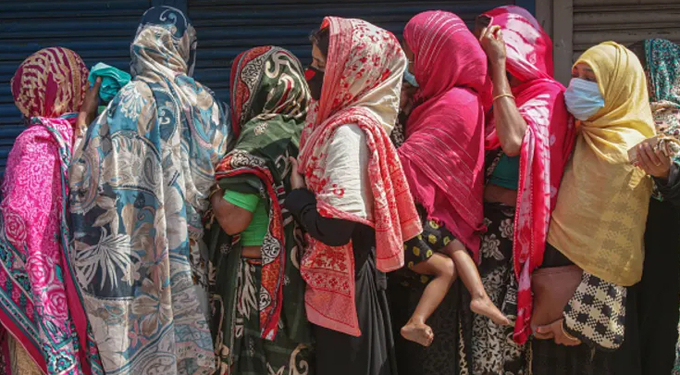November 28, 2025 | 01:01 GMT +7
November 28, 2025 | 01:01 GMT +7
Hotline: 0913.378.918
November 28, 2025 | 01:01 GMT +7
Hotline: 0913.378.918

The gap between men’s and women’s food security has grown 8.4 times since 2018. With the onset of Russia’s war in Ukraine, the situation looks set to deteriorate further.
The war has “put a lot of fuel on an already burning fire,” said Arif Husain, chief economist at the United Nations World Food Programme.
Ukraine is a major producer of commodities such as wheat, corn and sunflower oil. Although exports globally have been restricted due to Russia’s invasion, Husain said that the global food crisis is not driven by the availability of food, but surging prices.
“This crisis is about affordability, meaning there is food available, but the prices are really high” he said on CNBC’s “Capital Connection” on Monday.
According to figures from the U.N. Food and Agriculture Organization, global food prices in July were 13% higher than a year ago. And prices could keep rising. In its worst-case scenario, the U.N. estimates global food prices could jump another 8.5% by 2027.
Fertilizer prices are also rising, contributing to higher food prices as costs are passed onto consumers. Prices jumped after Russia — which accounts for around 14% of global fertilizer exports — limited exports. That in turn has dented crop yields.
That, combined with high energy prices and supply chain disruptions, will affect the World Bank’s ability to respond to the increase in food production over the next two years, said Mari Pangestu, managing director of development policy and partnerships at the World Bank. All that uncertainty could keep prices high beyond 2024, she said.
While the U.N.’s Husain argued the current crisis mostly stems from high prices and affordability issues, he said it could turn into a food availability crisis if the fertilizer crunch is not resolved.
The U.N. estimates the number of people in “hunger emergencies,” which it defines as one step away from famine, has jumped from 135 million in 2019 to 345 million, Husain said.
Heatwave in China
Extreme weather and climate change are also exacerbating conditions contributing to global food insecurity. China, the world’s biggest wheat producer, has suffered multiple weather disruptions, from flash floods to severe droughts.
Earlier this month, the country issued its first drought emergency as central and southern provinces suffered weeks of extreme heat, with temperatures in dozens of cities exceeding 40 degrees Celsius, or 104 degrees Fahrenheit. The heat wave has hindered crop production and jeopardized livestock.
“Rice production is certainly very vulnerable to changes in weather temperature,” said Bruno Carrasco, director general of the sustainable development and climate change department at the Asian Development Bank. “When we look at the overall supply of food production in Asia-Pacific, approximately 60% of that is rain-fed farming.”
“We are very concerned given the overall weather events that we’ve seen and observed over the course of the year,” he added.
A growing gender disparity in food access
Of the estimated 828 million people globally who were affected by hunger in 2021, around three-in-five (59%) were women, according to a report released earlier this month by humanitarian organization Care.
That’s equivalent to 150 million more women facing food insecurity than men.
And the gap is widening.
Since 2018, the disparity between men’s and women’s food security has grown 8.4 times, accelerated in part by the coronavirus pandemic. Now, with the onset of Russia’s war in Ukraine and accompanying food shortages, alongside wider inflationary factors, the situation looks set to deteriorate further.
“Not only is that a stark gap, it is a gap compared to 2018 that is growing rapidly,” Emily Janoch, Care’s senior director of thought leadership and one of the report’s authors told CNBC.
The findings, which draw on data from the United Nations and World Bank, report the state of play up to Dec. 2021. The fallout from the crises of 2022 will not be known until next year, but the forecast looks bleak.
“Everything that we’re seeing is telling us that it’s going to get worse,” Janoch said.
“If you look at the impact on agriculture following the Russian fertilizer crisis, the implications are astronomical. We don’t know exactly what they will look like, but we know they’re going to fall heavily on women and girls,” she said.
(CNBC)

(VAN) A new study reveals how the simultaneous effects of ocean acidification, salinity and loss of oxygen are making the world more fragile.

(VAN) Hopes are growing that the creation of the first 3D turkey gut model could be a turning point in the battle against the virulent blackhead disease.

(VAN) Tyson, America’s biggest meat supplier, plans to shutter one of its largest beef processing plants as the industry continues to struggle with low cattle supplies and political pressure from Washington.

(VAN) New FAO study shows how digital solutions are empowering farmers and fishers to prevent losses and build resilient agrifood systems.

(VAN) Brazil's COP30 presidency pushed through a compromise climate deal on Saturday that would boost finance for poor nations coping with global warming but that omitted any mention of the fossil fuels driving it.

(VAN) Poultry farmers in the UK have been warned that they could face one of the worst winters yet for bird flu.

(VAN) Prices of main-crop paddy have risen sharply, with jasmine rice hitting 16,100 baht per tonne — the highest level in years.